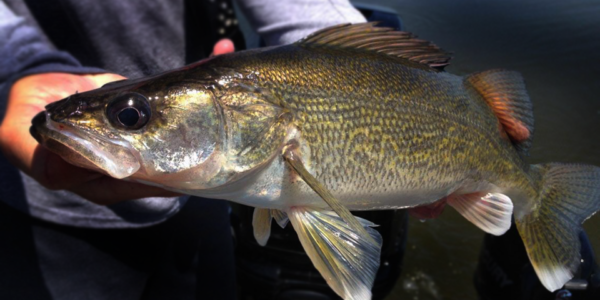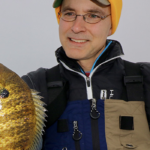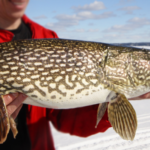The Future of Wisconsin and Minnesota gamefish resources and the necessity of reform among those who harvest our gamefish resources.
In 1835, old growth virgin forests lined the lakes and rivers of WI and MN. Negative human environmental impact was not yet a factor and gamefish species proliferated and flourished in the pristine waters. Human harvest of what are now considered gamefish species was limited to subsistence fishing conducted by sparse populations of indigenous people and newly arrived trappers, settlers, traders, prospectors, and explorers. The combined human population of WI and MN in 1840 was roughly 37,000. Harvest methods ran the gamut of netting, trapping, spearing, and angling. All utilized equipment would have been considered extremely crude by modern technological standards. However, due to the vast nature of fish populations, all methods were very effective if properly deployed.
Fast forward to modern day and almost nothing described in the previous paragraph holds true. The virgin forests, with large portions of white pines up to 400 years old and six feet across at the trunk, were clear cut within 70 years of the 1837 Pine Tree Treaty. Management and protected forests have grown back, but they are far from old growth status and share the landscape with heavy agricultural use. Many of our waterways have improved in health over the last 30-40 years due to increased and improved environmental regulation. However, all of our waters range from being at risk to moderately polluted from human impact. The combined population of WI and MN is now roughly 11.3 million. Human use of the states’ gamefish populations range in nature from subsistence and commercial harvest to total catch and release sport angling. Methods include netting, spearing, and angling; and much of the equipment used is advanced to a rate commiserate of modern technology. Methods and tools we use to capture fish are so effective, and so many individuals are utilizing gamefish resources, that both legal regulation and non-mandated ethical practices must be used to prevent the destruction of gamefish resources. Often, neither are properly employed, and thus many of our populations of gamefish in various water bodies are constantly in severe decline or in total collapse altogether due to gross over-fishing.
We are quickly reaching a tipping point with many gamefish populations in MN and WI. Many of the Earth’s fish resources, both salt and fresh water, have already reached this tipping point and been mostly lost due to irresponsibility, greed, and lack of knowledge. The possibility of this happening to many WI and MN gamefish resources is real whether we choose to believe it or not. A local and recent example of this is the Red Lake walleye population crash of the late 90’s, but anyone who has seen a good bluegill or crappie lake “fished out” has witnessed this first hand. Instinctually, it is still in our human nature as hunters and gatherers to take as much as we can in order to be successful. I can’t imagine there are many fishermen who haven’t felt this urge when having a good day on the water, it is only natural. I have felt this urge too many times to count, and admittedly I have given in to it in the past. Everyone makes mistakes, but making mistakes should not be a common and accepted practice. We all need to learn from our mistakes, and stop making as many.
Our advancements as a species have allowed our population to explode. We have created the ability to provide usable food, water, and shelter to a staggering number of people; and thus the human population has in many ways exceeded the true carrying capacity of the Earth’s resources. If even a small percentage of the Earth’s current population went out and continually took all the fish they could catch, very quickly there would be almost nothing left. The Mediterranean Sea and much of both fresh and salt waters of Africa and southeast Asia are prime examples of this.
The strongest populations of gamefish worldwide exist only where there are the fewest people using the resources and/or effective regulations are in place and enforced. Remote waters in the wilderness of Canada are a prime example of this. They are healthy, properly regulated, and have minimal human impact of any type; and therefore gamefish proliferate within. These are prime fishing destinations, and this is the reason many residents of WI and MN save money all year (or longer) just to afford one short trip there. Sadly, our home waters would be capable of growing populations of gamefish equal to those of Canada if we were to regulate properly, both legally and voluntarily. However, this is not what is currently happening. Chippewa tribal members of WI and MN that numbered 3,000-7,000 (estimates vary greatly) in the early 1800’s now stand at roughly 65,000 individuals that possess various rights to harvest certain gamefish populations with various methods and in various amounts. Combine that with over 2 million licensed sport anglers between the 2 states, and the potential for gross overfishing should become very clear. Some of our gamefish populations are still good, but they could all be exponentially better.
To make matters worse in WI and MN, conflict between different interest groups are causing spiteful and wasteful actions on the part of people from involved parties. Many individuals place great value on one resource in a specific water body and commit wanton waste on another they don’t value or see as detrimental to what they view as valuable. Others have the attitude that if they don’t harvest a fish, someone else will anyway, so they may as well harvest it. Some people justify massive harvest (often unlawful) by noting that it is unethical and unconstitutional for the resource usage of two different groups to be regulated differently. Some spitefully harvest or kill and waste fish for little or no reason, other than to ruin something for someone else. Regardless of motive or legality, such actions are wasteful and shameful. If continued, they will only cause harm to our gamefish populations and no good will come of it.

One day of tribal musky harvest on a WI inland lake. This is legal but arguably unethical, as no musky population can stand up to this level of harvest pressure.
Two such interest groups that both have members that arguably engage in spiteful, unethical, wasteful, and/or illegal practices are native tribal harvesters and nontribal sport anglers; whose usage of gamefish resources often conflict and become points of contention. Historically, relations between Native Americans and Non-Native Americans in WI and MN were hit or miss, but quickly deteriorated after the treaties of 1837, 1842, 1847, 1854, 1855, and 1864; which (among other things) ceded lands for natural resource extraction, created reservations, and granted native Chippewa continued usufructuary fishing rights in much of the ceded territories. Prior to the Voight decision in 1983, the before mentioned usufructuary rights were largely ignored or denied outright, and treatment of tribal people was largely dismal. In the 1980’s, when U.S. Appellate and Supreme Court decisions fully honored the before mentioned treaties, restoring Chippewa usufructuary fish harvest rights in some of the ceded territories of WI and MN, conflict (seldom violent) erupted when tribal harvest resumed. Many non-tribal members thought it would bring about the destruction of gamefish resources. There are strong arguments that the added tribal harvest pressure has had a negative effect on certain gamefish resources, but the Chippewa are certainly not the only interest group to blame when it comes to the decline of our fisheries. Unfortunately, strained relations between non-tribal and tribal fishermen have prevented cooperation and positive change in most instances.
I am certainly not innocent in any of this, but as I grow older I begin to grasp and come to terms with the error of my ways and the ways of others. I also realize the need for full cooperation amongst everyone who utilizes gamefish resources in any manner. For the most part, the manner and means by which different groups legally use gamefish are unimportant, and arguments regarding whether or not it is just to have different sets of laws regarding harvest methods and amounts for different groups are moot and fruitless, as these laws are unlikely to change any time soon. That being said, harvest methods that involve indiscriminate killing with no means of selective or limited harvest, such as gill nets, are extremely detrimental and should not be used.

A conservation warden posing with fish confiscated from a non-tribal sport angler in gross violation. Illegal and unethical practices pose a grave threat to gamefish populations.
What is extremely important, is the extent to which each of these groups impacts gamefish populations. I understand it is a tough sell, but if things are going to get better instead of worse, everyone needs to have respect for everyone else’s heritage, legal rights, and interests. Also, everyone needs to have respect for all gamefish, the environments in which they live, and the complex ecosystem they comprise. WI and MN gamefish resources should not be used as a primary means of feeding individuals, families, or communities (tribal or non-tribal); there are not enough fish to go around and maintain robust populations. Unless an individual or a family is living completely off the land and off the grid (with no modern amenities or services that require money or economic connection), it is more important for survival to be connected to local, national, and global economies than it is to harvest fish for nourishment. Harvest for commercial gain is also an extremely risky proposition and should only be allowed if fish that are sold in one manner or another are allotted from existing reasonable pre-set harvest quotas.
Honoring traditions, providing for people, experiencing gamefish resources, and eating self-harvested fresh fish are all wonderful things, but not if it is done in an amount that causes gamefish populations to go into decline. For gamefish populations to improve, it is going to be necessary for everyone to realize that this is not about instant gratification, and that some sacrifice is necessary to provide better gamefish resources for future generations, and the rest of our own generation. Gamefish populations are very resilient and noticeable to large improvements would be apparent within 3-10 years of proper cooperative management. Shortly after that (5-10 years), appropriate biomass would be reached, and the gamefish populations in our waters staggering. From that point on, reasonable harvest quotas could be set that would maintain gamefish populations at high levels, and still provide for harvest that would be considered plenty by the standards of any reasonable individual.

An abandoned, discarded, or lost gill net full of dead and wasted gamefish on the shore of Mille Lacs. Only tribal harvesters are allowed to use
gill nets on Mille Lacs.
Reaching and maintaining proper gamefish biomass is the key to creating and maintaining healthy populations of naturally reproducing gamefish. Rather than starting with strong numbers or rebuilding populations, then bringing them down to nothing and starting all over again; we need to maintain huge healthy populations and collectively take only an amount that would not bring said population into decline. Whatever that amount is, that is what everyone needs to be satisfied with, or eventually we will just take and take until there is nothing left to bring back. This can realistically be done through selective and limited harvest.
When our gamefish resources flourish once again, the economic benefits will be very apparent. Out of state tourism will increase heavily. This will bring in more out of state money to our local economies (including reservations). In turn, the earning potential of local households will increase, which translates to money that can be spent on groceries; eliminating the necessity of using gamefish resources to prevent families from experiencing food shortages. WI and MN residents that once went to Canada will then be able to fish regularly and successfully all year in the regions in which they live for the price of one Canadian fishing trip. When the potential quality of our fisheries is reached, the choice between the two options would be easy. This will also strengthen local economies, by retaining local money instead of losing it to Canada. These natural resource, social, and economic benefits are all extremely attainable if we realize that we all love the same thing, set aside our differences, and work together to make all of our gamefish populations amazing.
Of course, at this point, I expect the readers of this article to be wondering if I actually have a workable plan by which the goals I mentioned could be achieved. I realize that if I don’t have a plan, every word prior to these are nothing but trash talk, B.S., and hypocrisy. That being said, I do have a simple streamline plan that I am confident would work and maintain not only amazing gamefish resources, but also the honor and integrity of everyone’s traditions and practices. My proposed management plan will be published in next month’s (April) issue of Honest Musky Newsletter and shared with readers of Fishing-Headquarters Online Magazine.
For more content, including video from Honesty Musky Television, Honest Musky Guide Service, Seminar Topics and Availability, and more articles; visit: www.honestmusky.com
Adam Glickman is an independent agent who shops across 9 different A rated insurance companies to best meet your MN and WI home, renters, auto, life, boat, and commercial insurance needs. For more information, contact Glickman at 612-750-0546 or at adam@lcisagency.com







